4 unwanted visitors you might find in your chicken coop
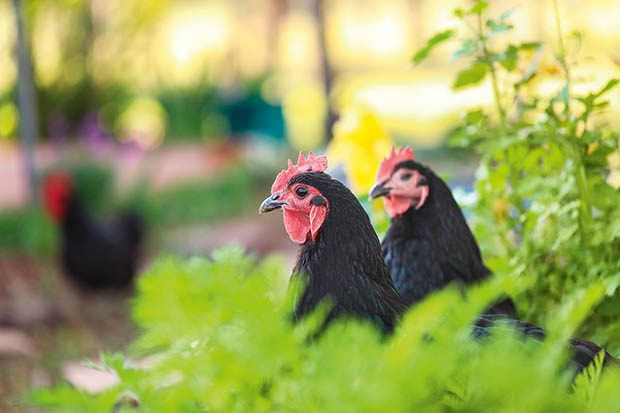
Sometimes the coop can hold bad news.
Words: Nadene Hall
1. A DEAD CHICKEN
It’s important to investigate any death, especially a sudden one.
Questions to ask include:
• In hindsight, were there any symptoms, and are other birds showing similar symptoms?
• can you eliminate all environmental causes, such as overheating, chilling, lack of food, lack of water, predators, or smothering?
• have you recently introduced new birds you’ve brought in from another place, eg rescue hens?
• have you taken birds to a poultry show?
• what age are/were the affected birds?
In rescue hens – hybrids that spent the first 18-24 months of their lives on a commercial farm – the cause may be old age, which in their case is 3-5 years. Hybrids are bred to lay a lot of eggs in a short time, but not for longevity. Their ‘old age’ is a lot younger than heritage and cross-breed birds which can live for 5-10 years or more.
If a bird looks like it has died in its sleep, common reasons include:
Heart attack
This is more likely in heavy, overweight birds such as older roosters or fast-growing meat birds. It can also occur in birds that haven’t fed in a while, which then gorge on feed. This can put so much pressure on the crop that it blocks blood vessels to the heart.
Salmonella
This can be a sudden and overwhelming bacterial infection, so a bird that looked fine one afternoon can be dead the next morning.
Gout (Urolithiasis)
This is a blockage of the tubules in the kidney tubules caused by crystals in urine. It’s more likely in young birds (18+ weeks) that were fed layer food too soon (before 16 weeks). Layer feed is much higher in calcium than chick feed and can cause fatal build-ups of crystals in the kidneys.
Adult hens and roosters excrete the excess in their urine, and blockages don’t tend to happen as the kidney tubules are much bigger.
Coccidiosis
Some strains of coccidiosis, such as Eimeria necatrix, can cause sudden death, with no other common ‘cocci’ symptoms (eg, blood in faeces, birds looking fluffed up and depressed). Birds may look a little ‘off’ one day and drop dead the next.
Stress
This includes heat stress – chickens don’t sweat and need good shade and lots of fresh, cold water on hot days – and stress to the body from getting a fright, eg scared by a dog, a loud, sudden noise.
Predator
There are a few options: cat, stoat, ferret, rat. You may need to use a trail camera to identify the culprit. Look for droppings, which you’re more likely to find if it’s a stoat, ferret or rat. To identify droppings, head to Pest Detective.
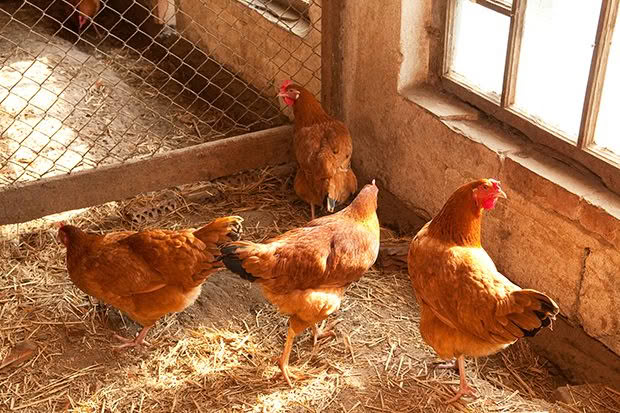
What if you find lots of dead chickens?
If you find many or all of your birds dead, the first suspect is a predator, and the first name on the list is dog.
Signs of a dog attack include lots of chickens killed but not eaten, dead birds piled in a corner, and – if there are any – very anxious survivors.
It can be difficult to see the cause of death, as often the puncture wounds from teeth close over in the skin – dogs usually grab, shake the bird, then let it go. Birds may also die from fright or from being smothered (if they all crowd into a corner).
What if you find lots of dead birds all in one corner?
Smothering is more common in large commercial poultry sheds but can also occur in a backyard coop.
Causes include panic (caused by a predator, sudden noises, changes in light), too many hens crowded into a nest box, and sometimes by a sudden drop in temperature when birds huddle together for warmth.
2. ASHY RESIDUE ON WOOD FRAMING OR PERCHES
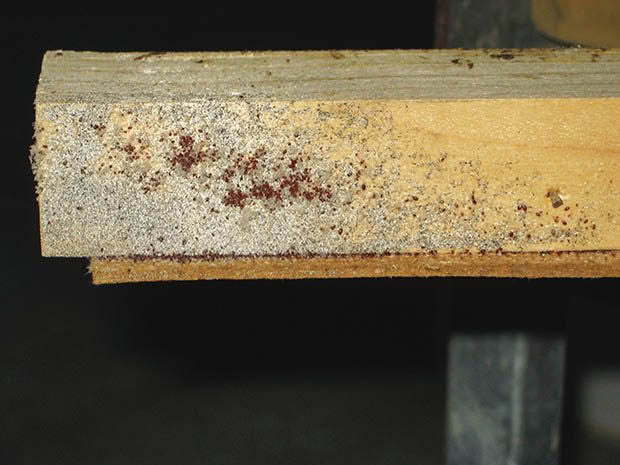
Cigarette-like ash on the wood inside your coop is a sign there’s a serious infestation of red mites (Dermanyssus gallinae). You’ll often see large grey patches (mites that haven’t yet fed) with red patches (mites that have fed).
These tiny (just under 1mm) bugs live in large groups hidden in the joinery of your hen house’s walls. They only come out at night to feast on the blood of nearby birds. Red mites cause irritation and blood loss, run down the immune system, and carry diseases. They can cause death due to anaemia, and their effect on the bird’s overall health.
It’s often only when red mites are infesting a coop that you may notice their effects on your flock, such as:
• feather pecking;
• restlessness at night;
• choosing to lay eggs and perch outside the coop;
• scratched, crusty skin;
• dirty-looking feathers;
• pale comb and wattles.
How to prevent an infestation
Mite populations can explode when they have optimal conditions such as warmth and humidity, and eggs can be viable for up to two years.
• inspect your coop every week – the sooner you find an infestation, the better, as it’s much easier to control a small number of mites.
• at night, use a bright torch to check birds on the legs and breast;
• during the day, use a torch to inspect nest boxes, where perches join walls, and gaps in the coop frame.
• paint wood framing a light colour, and use a silicone sealant to fill in cracks, so the coop interior is smooth and gap-free. This makes it much easier to see and treat mites.
• research shows the cleaner the coop, the lower the mite population. Remove wet or dirty litter daily, and regularly add a thick layer of fresh litter.
• nest boxes are a prime hiding place for mites. Consider using plastic nest boxes (eg, repurpose plastic trays, bins etc) as these are easier to remove, clean, and treat.
4 ways to control red mites
1. Use Exzolt®, a parasiticide for chickens that eliminates 99%+ of red mites. It’s only available from vets, who will dispense it in small amounts (Exzolt® is sold to them
in 10,000 dose containers). There’s no witholding period for eggs, and a 10-day witholding period if you’re processing birds for meat.
2. Clean the coop, then treat it with a product designed for red mite eradication. There’s a wide range available from poultry and rural supply stores, including diatomaceous earth (DE), sprays such as Extinosad, and powders.
3. Use a thyme essential oil spray (1 litre water to 25ml thyme essential oil) and thoroughly spray the coop on a coarse droplet setting. Thyme essential oil can kill all life stages of the red mite, is safe for poultry, and relatively non-toxic to non-target species. It’s also persistent, affecting mite population density for up to 30 days.
4. Use neem oil traps. Mix up 20 parts neem oil to 80 parts water and place in containers near common infestation sites – make sure birds can’t drink out of them. Replace every week.
3. BAD EGGS
This funny-looking egg doesn’t look that gross, but some people can be a freaked out because it’s squishy.
An egg with no shell may be a one-off occurrence for a hen. It may occur because her oviduct isn’t quite ready, or if a bird gets a fright as the shell is about to form, the egg may pass through without one.
If a hen is continually laying shell-less eggs, she may:
• have an infection in the shell gland;
• have egg drop syndrome (EDS), an infectious disease that can also cause other egg deformities (small size, soft shells);
• damage to the shell gland.
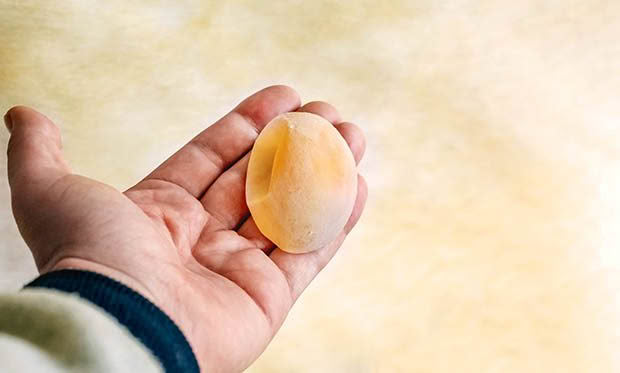
Another gruesome find is an egg with blood on it, sometimes completely coating much of the shell.
This is most common in young birds that are just starting to lay, caused by a burst blood vessel inside the oviduct. The oviduct stretches as an egg passes through it, and small tears may occur during the first few weeks of laying.
Other causes include an injured vent (where the egg emerges from the hen’s body). Check all your hens to see if there is an injury – other birds will be attracted to the blood and will peck at it badly enough that the bird dies.
If you crack open an egg and find blood spots or large quantities of blood surrounding the yolk, it indicates a rupture in the ovary as the yolk is released. It’s not a chick embryo. A partially-incubated egg would have a network of veins over the yolk radiating from a central point.
A small pink inclusion – usually found in the albumen, not on the yolk – is called a meat spot. It’s most likely to be a tiny piece of oviduct tissue that has come free and been included inside the contents before the membrane forms.
4. EGGS THAT AREN’T EGGS
These little horrors might resemble something left by an alien or even part of an internal organ. Confusingly, they are often egg-shaped.
Pictured above is a classic ‘lash’ egg – this one has been cut up to show what’s inside. Lash eggs often have layers, and may contain blood, what appears to be flesh, or creamy-yellow scrambled egg-like matter.
Sometimes they’re part of the bird’s oviduct, which has sloughed off, usually part of the uterus or shell gland. It may also incorporate folded-up membrane, caused by irritation of the oviduct (which secretes the membrane and shell).
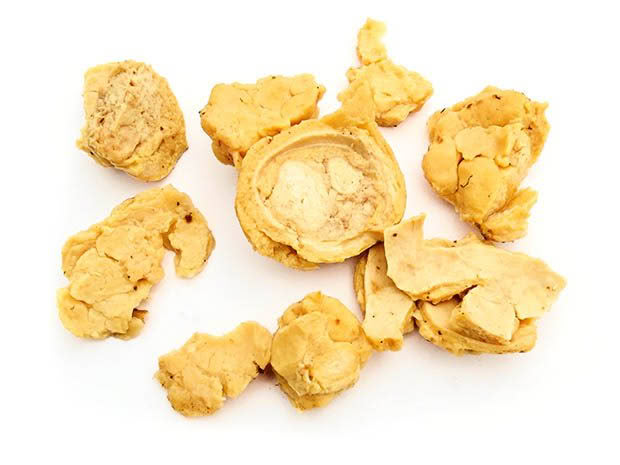
Other causes of lash eggs:
• salpingitis, an infection of the oviduct usually caused by the bacteria E. coli;
• egg peritonitis, which can also cause runny yellow droppings and a distended abdomen (caused by egg matter migrating into it from the oviduct).
A bird that lays a lash egg may recover and return to laying normally.
However, if it’s made up of hardened pus and yolk material as a result of an infection, the bird will show other symptoms, such as a hot, distended abdomen. They tend to gradually decline and should be humanely euthanised.
Love this story? Subscribe now!
 This article first appeared in NZ Lifestyle Block Magazine.
This article first appeared in NZ Lifestyle Block Magazine.
